Approximately 700 Pieces from Hokusai's 70-Year Artistic Career on Display at the Grand Palais
Seiji Nagata (Director of the Katsushika Hokusai Museum of Art)
The HOKUSAI exhibition, held at the Reunion de Musees Nationaux - Grand Palais (Rmn-Grand Palais) in Paris, France, from October 1, 2014 to January 18, 2015, attracted an astounding 359,000 visitors.
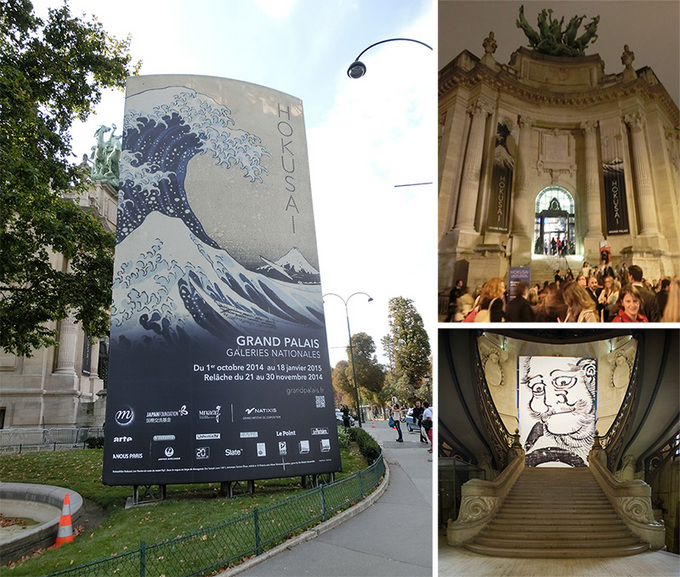
Bottom right © Mirco Magliocca pour la Rmn-Grand Palais, Paris 2014
This exhibition was organized jointly by the Japan Foundation and the Rmn-Grand Palais, with the original intention of commemorating the 200th anniversary of the publication of the Hokusai Manga (1814), which was one of Hokusai's representative works. The exhibition was supervised by the Paris organizers under Laure Dalon, Assistant Scientific Director of the Rmn-Grand Palais, who takes charge of a wide range of works in France reflecting the influence of Hokusai. The works of Hokusai shown in this exhibition were curated by the writer of this article, that is, Seiji Nagata. As many as approximately 700 pieces were put on display, and 534 of these were works by Hokusai. The scale of this exhibition greatly exceeded that of the legendary Hokusai et son temps exhibition held at the Marais Cultural Center, also in Paris, from October 1980 to the following year.
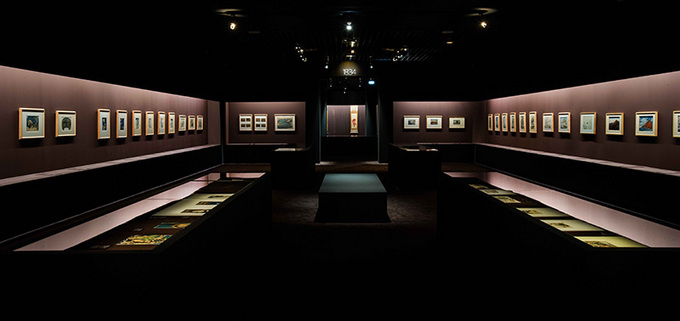
© Mirco Magliocca pour la Rmn-Grand Palais, Paris 2014
Incidentally, why was the decision made to hold an exhibition in Paris of such a large scale as this, in order to commemorate the 200th anniversary of the publication of the Hokusai Manga? The reason for this lies in the following story.
When a famous Parisian copperplate engraving artist, Felix Bracquemond (1833 - 1914), visited his printmaker friend, Auguste Delatre, he was shown a copy of the Hokusai Manga, which had arrived in the form of buffer material for porcelain sent from Japan. At first glance, Bracquemond was astonished by the excellent skills, unusual ideas, and rich contents of the work, which resembled nothing he had ever seen before till then. He subsequently developed a heartfelt fascination with its artist Hokusai. After that, he somehow got his hands on the Hokusai Manga, and publicized it widely amongst his artist friends. As a result, Hokusai's name began to spread in Europe, and imposed an even greater influence on the Impressionists who came afterwards. This was generally believed to have taken place in 1856. However, no chronological proof exists, and there are also strong views that this could have taken place at a later date. If this story were to be true, it would mean that in the short span of just seven years after Hokusai's death, the Hokusai Manga was found in Paris, and Hokusai's name was spread across Western Europe as a result.
Against this background, it was decided that Paris would be the most suitable place to hold this HOKUSAI exhibition, at a time that would correspond perfectly with the 200th anniversary of the publication of the Hokusai Manga.
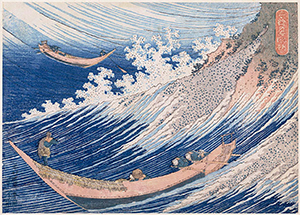
Soshu Choshi, from the series Chie no umi (One Thousand Images of the Sea), Collection of the Musee Guimet
© Rmn-Grand Palais (Musee Guimet, Paris) / Thierry Olivier
In light of these considerations, we approached the planning of the exhibition based on three concepts. The first was to fill up one floor with more than 100 items of several groups of works, most of which were his first publications, with related materials, in order to gain a renewed awareness of the colorful artistry of the Hokusai Manga.
The second was to trace the years of his creative career in chronological order, which spanned about 70 years, in order to create an exhibition that could facilitate an all-rounded understanding of Hokusai's art. With that in mind, a wide range of works was selected without placing a particular emphasis on any artistic format. These included nishikie, surimono, egoyomi, hanshita-e, gako, kyogo-zuri, hanpon, nikuhitsu-ga, and other letters, covering a range that had never been seen before in previous exhibitions.
The third, as I had already touched on earlier, was to create a floor for displaying paintings and craftwork, with the aim of introducing the acceptance of Hokusai's art in France.
It is the earnest desire of this organizer that the exhibition will trigger a rediscovery of the true greatness of Hokusai's art, not only among the Japanese people, but also amongst the people of France and other parts of Western Europe today, approximately 160 years since the story of Bracquemond.
Editorial notes
Nishikie: polychrome woodblock prints of Ukiyo-e
Surimono: A limited edition of ukiyo-e prints privately issued
Egoyomi: Picture calendars meant for the illiterate
Hanshita-e: Sketches drawn for the use of etching prints on wood
Gako: Draft sketches of drawings
Kyogo-zuri: Prints of black outline of the work
Hanpon: Books printed by woodblock print
Nikuhitsu-ga: Ukiyo-e drawn directly onto a silk canvas or paper
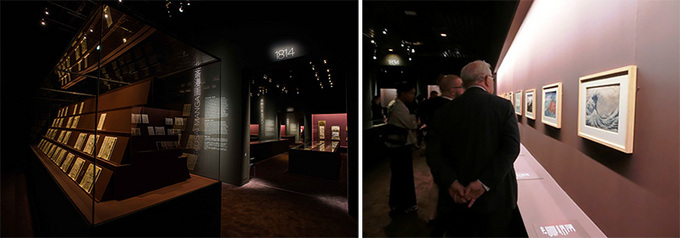
(Left) © Mirco Magliocca pour la Rmn-Grand Palais, Paris 2014
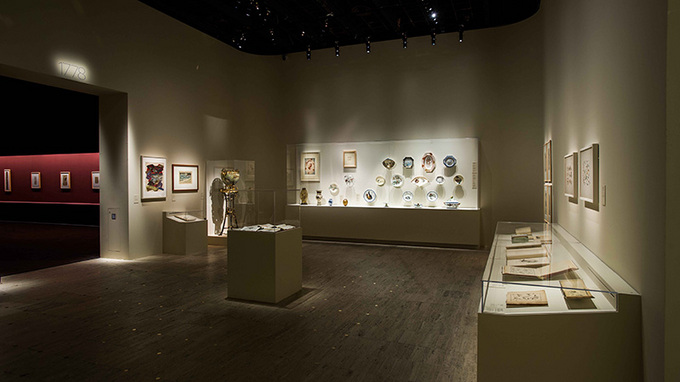
© Mirco Magliocca pour la RMN-Grand Palais, Paris 2014
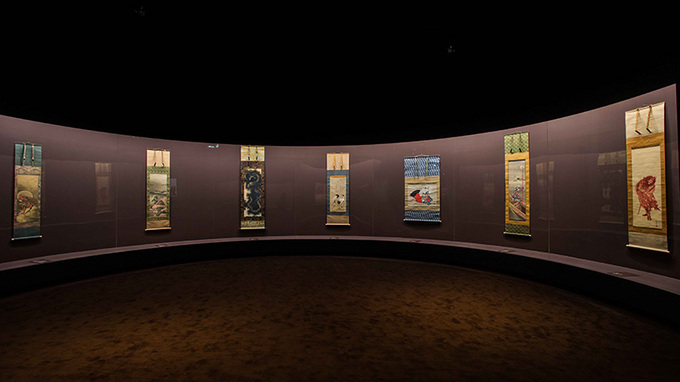
© Mirco Magliocca pour la RMN-Grand Palais, Paris 2014
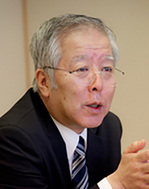 Seiji Nagata
Seiji Nagata
Director of the Katsushika Hokusai Museum of Art. Nagata is an Ukiyo-e researcher and critic. He was born in Tsuwano in 1951, and first encountered Hokusai through a used book when he was in elementary school. Since then and through the present day, he has continued to be fascinated by the works of Hokusai. After working as the Assistant Director of the Ukiyo-e Ota Memorial Museum of Art, he established the Katsushika Hokusai Museum of Art in Tsuwano. As a leader in the field of Hokusai research in Japan, Nagata has been involved in the planning of various exhibitions in Japan and overseas. He served as supervisor (guest curator) for the Hokusai exhibition held at the Tokyo National Museum in 2005, and wrote the introductory text for the catalogue. The exhibition later toured the Arthur M. Sackler and Freer Gallery of Art in Washington, concluding with great success in both Japan and the U.S. He has also written or compiled numerous books on Hokusai and Ukiyo-e.
Main publications:
Motto Shiritai Katsushika Hokusai - Shogai to Sakuhin (Want to know more about Hokusai - life and works, Tokyo Bijutsu, 2005)
Rekishi Bunka Raiburari <91> Katsushika Hokusai (History and Culture Library, Yoshikawa Kobunkan, 2000)
Nihon no Ukiyo-e Bijutsukan.(Ukiyo-e Art Museum in Japan, Kadokawa Shoten, 1996)
Shiryo ni Miru Kindai Ukiyo-e Jijo(Situation of Modern Ukiyo-e through Documents, Sansaisha, 1992)
Hokusai Bijutsukan. (Hokusai Museum of Art, Shueisha, 1990)
Back Issues
- 2025.6. 9 Creating a World Tog…
- 2024.10.25 My Life in Japan, Li…
- 2024.5.24 The 50th Japan Found…
- 2024.5.24 The 50th Japan Found…
- 2024.5. 2 People-to-People Exc…
- 2024.5. 2 People-to-People Exc…
- 2023.12. 7 Movie Theaters aroun…
- 2023.6.16 The 49th Japan Found…
- 2023.4.24 The 49th Japan Found…
- 2022.12.27 Living Together with…

